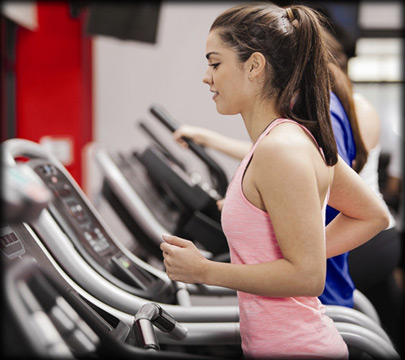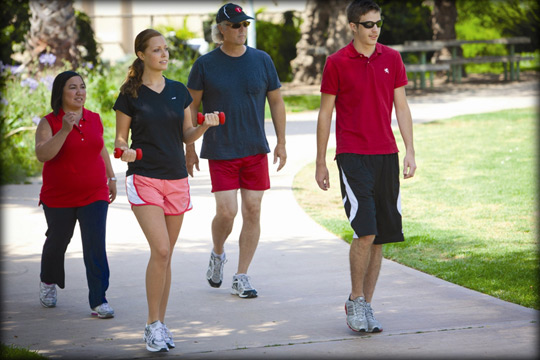Walk for health, fun and fitness
By Lionel Wijesiri
My case history is, I think, typical enough. I am now a
septuagenarian and, as my physician says, “Fit and healthy.” By age 40,
however, I was well on my way to cardiovascular bankruptcy.
The seat of my pants was the only working physical resource I had
left. When it wasn’t parked in an office chair, it was settled down
inside a car on its way to somebody’s living room sofa. I needed a
four-wheeler vehicle to fetch my three-kilo sundry requirements from the
town just a little over a kilometre from my home.
|

Outdoor walking and treadmill workouts offer the benefits of
walking but, there are distinct advantages and disadvantages
to each. |
The idea of walking never occurred to me. In fact, I had put away
those as “childish” concepts. Unfortunately, it took me a decade or more
to realise that price of such “maturity” was very high.
My first experience arrived one day when one of my neighbours
organised an alms-giving ceremony to Maha Sangha in memory of his
deceased wife. I was suddenly asked by him to attend to the traditional
feet-washing of the Sangha as they stepped into the house. It was meant
to be a simple chore but by the time when it was finished, I was dizzy,
weak-kneed and needed someone else to help me to rise.
My second experience came when I was cutting across my neighbour’s
backyard, I had to step up a stone ledge about three inches high. I made
it only after two tries, and my legs trembled all the way to the house.
I finally realised that something is wrong with my body. I had, in
short, forgotten what it was like to have a body that was not a burden.
Things are better since then and today I have a satisfaction at my
recovery. By now, no doubt, you might conclude that I have become a
jogger. In technical sense, I concede the point but in major sense, I
deny it. As commonly practiced, jogging is done to achieve something
other than itself - like weight loss or muscle tone.
By my principles, exercise makes sense only if it is the by-product
of some more human activity. It is the refreshment of the mind which
counts most; the body goes along for the exercise, but it sits in the
back seat. That’s why I call my daily recreation “moderate-intensity
walking” (or in simple terms, “brisk-walking”) and not jogging.
Best results
With two decades’ experience in brisk walking behind me, I believe, I
have enough know-how to answer a couple of questions people usually ask
about this exercise.
How do you get the best results of walking?
The most important ingredient is that you plan your routine before
starting your exercise.
Remember to get the right gear. Choose shoes with proper arch
support, a firm heel and thick flexible soles to cushion your feet and
absorb shock. If you walk outdoors when it’s dark, wear bright colours
or reflective tape for visibility.
Choose your course carefully. If you’ll be walking outdoors, avoid
paths with cracked sidewalks, potholes, low-hanging limbs or uneven
turf.
Warm up. Walk slowly for five to 10 minutes to warm up your muscles
and prepare your body for exercise.
Cool down. At the end of your walk, walk slowly for five to 10
minutes to help your muscles cool down. Stretch. After you cool down,
gently stretch your muscles. If you’d rather stretch before you walk,
remember to warm up first.
Guidelines
Exercise guidelines generally suggest that for health purposes,
adults should engage in 30 -45 minutes of moderate-intensity activity
most days of the week (or minimum 150 minutes every week). For brisk
walkers, a moderately intense pace would probably be about 10 to 12
minutes per kilo metre.
It has generally been assumed that if people walk more slowly but
expend the same total energy as brisk walkers - meaning that they spend
more time walking - they should gain the same health benefits. But few
large-scale studies have proven that the impact of moderate- intensity
walking, is better for your body and mind.
How do you make walking more challenging?
If you’re already fit, kick up the intensity by doing one or more of
the following:
Speed up. “The easiest way to up the ante is to simply walk faster,”
says Therese Iknoian, author of Fitness Walking. You may want to try
race walking, which burns more calories. Brisk walking at 6.5 km an hour
burns 334 calories, and strolling at 5 km per hour burns 221 calories,
according to the American College of Sports Medicine. “Remember to pump
your arms but keep the movement compact,” Iknoian says. “The larger the
arm swing, the harder it is to move them faster.”
Start slowly and try to build your walking regime gradually. To get
the health benefits from walking, it needs to be of moderate-intensity
aerobic activity. In other words, it needs to be a little faster than a
stroll.
You have to walk fast enough to raise your heart rate and break into
a sweat. One way to tell is that you’ll be able to talk, but not sing
the words to your favourite song.
Walking technique
A good walking technique is key to staying healthy and improving
fitness.Certified fitness professional Jolynn Jaekel explains, “The
first rule of exercise is always engage your core muscles. This is
particularly important in walking because you are upright the whole time
and supporting your entire body weight.
|

Start slowly and try to build your walking regime |
So tighten your stomach muscles. The best way to do this is to make
sure you are not slouching when you walk. Spinal alignment is part of
this core strength. You should stand straight, trying not to lean too
far forward or backward with your chin parallel to the ground.”
Of course, you want to be mindful of potential hazards in your path,
just keep your gaze a few feet in front of you instead of right at your
feet. Let your arms swing naturally and roll through your foot from heel
to toe.”
Try to walk 10,000 steps a day. Most of us walk between 3,000 and
4,000 steps a day anyway, so reaching 10,000 isn’t as daunting as it
might sound. If, to begin with, you can only walk fast for only 10
minutes, that’s fine. Don’t overdo it on your first day. You can break
up your activity into 10-minute chunks, as long as you’re doing your
activity at a moderate intensity.
Treadmill
Because time is often a factor, many people wonder which activity -
walking outdoors or walking on a treadmill - will give them the best
workout for their effort. Though both workouts offer the benefits of
walking, there are distinct advantages and disadvantages to each.
Unlike the treadmill, walking is a low-impact activity; stress on the
joints of the legs, hips and back is minimal. Those new to exercise are
often attracted to walking because it does not need an additional skill
or significant equipment.Individuals recovering from injury can also
reap the benefits of walking without less risk of re-injuring
themselves.
The varied terrain, combined with the neural-muscular response to
outside stimuli, keeps the brain engaged in the workout as well.
Because the walking surface - whether it be concrete, grass or a
trail - is slightly modified with each step, the walker must integrate
these changing perceptions to maintain a comfortable stride.
Additionally, you must overcome air resistance while walking outdoors.
|

